Almanac Article
Growing Pacific Coast Iris in Southern California
Richard C. Richards, La Mesa, California
Almanac, Fall 2002 Vol.31, No.1: 6-7
[Adapted and slightly modified for the web]
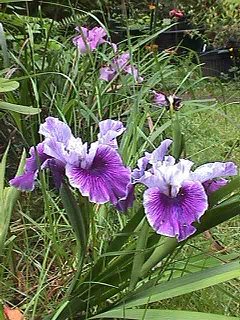
by Joseph Ghio 1990,
at Maxwell Valley Gardens,
Clinton, Washington
The PCIs are beardless irises that grow wild in California, Oregon, and Washington. They have been placed in the series Californicae, based on their ability to interbreed and their identical chromosome numbers. The series includes eleven species and three subspecies. There are also many naturally occurring interspecific hybrids, and enthusiasts have produced new hybrids derived from virtually all the species in the series.
I use the term PCI to include both the species and the interspecific hybrids, many of which are garden irises.
Many of the new garden hybrids are available today, usually from specialty plant nurseries. They can also sometimes be found in the general garden trade. Most of the new hybrids spring from five species: I. douglasiana, I. innominata, I. tenax, I. bracteata, and I. munzii. A few wild-collected species clones have been introduced as garden varieties, but this is unusual.
Long-term hybridizing has made the new PCIs a somewhat more dependable garden plant than the wild species. The species tend to adapt poorly to garden conditions, and need very special conditions for survival. The exception for southern California is the Douglas iris, I. douglasiana. It's southern distribution extends nearly to Santa Barbara, and it is quite tolerant of a wide range of growing conditions.
Soil Preparation for Growing PCIs
Good soil preparation can make the difference between excellent growth, or little growth followed by sudden death. Most soils in southern California are alkaline and need to be altered to neutral or slightly acid. This can be done in several ways. One is the addition of soil sulfur, applied at 5 lbs. per 100 square feet. Another involves adding copious quantities of peat moss - spread it on the soil at least two inches deep and spade it in. Using both soil sulfur and peat moss is better than using only one, and the soil sulfur adds grit to the soil.
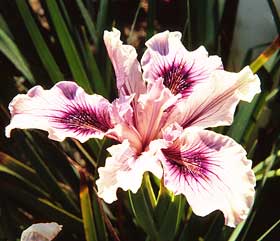
Most soils in southern California are heavy, usually clay or adobe, and need to be lightened considerably. Soil sulfur and peat moss will help, but with heavy soils the addition of gypsum at the rate of a pound per square foot is also recommended. You do not need this if your soil is already light, sandy, or gritty. In that case just add even more peat moss.
Adding alfalfa pellets to the soil also seems to stimulate growth. A pound per two square feet will help considerably.
Mix in all your ingredients thoroughly and keep the soil moist for a few weeks before planting. That is ideal. I have planted into newly mixed soil with no detrimental results.
A light soil pays extra dividends at transplanting time - tender growing roots are less likely to break when removed from a well-prepared soil.
Plant Location
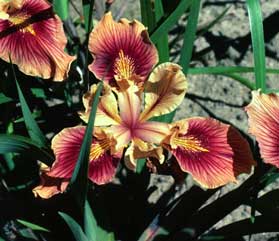
In all but coastal areas, partly sunny to medium shady conditions are best. Most varieties will not tolerate sun all day long, and will not bloom if planted in heavy shade. I have raised PCIs successfully in the Riverside area in sites that were either dappled shade, or up to half a day of sun, preferably morning sun.
Plants do fine even if subjected to occasional frosts, snows, and temperatures down into the 20-degree F. range for short periods.
Watering
Most garden hybrids and named varieties require watering at least every week to ten days. I water twice a week in summer, usually in the late afternoon or evening, and whenever the soil gets dry year around. A light redwood compost mulch helps reduce soil temperatures and retain moisture, but it should be kept at least an inch or two away from the base of the foliage. I do not mulch except in rare conditions.
Transplanting, Dividing, and Replanting
In southern California, the timing of transplanting and replanting is crucial. Success is most likely only in December, with the beginning of new root growth and when the roots are just an inch or two long. The less time the plants are out of the ground, the better. Roots should never be allowed to dry out. If the day is warm, I throw the divisions into a bucket of water until I am ready to pot, prepare for transportation, or put back into the ground.
Avoid breaking the new white roots. They are easiest handle when two or three inches long. The risk of breakage is higher as the roots get longer.
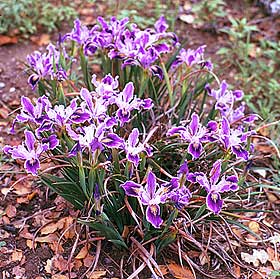
at the Santa Barbara Botanical Garden in California
If two or three rhizomes are growing close together and connected, it is best to leave them as one division. Divisions with a single growth tip are more likely to become permanently deciduous in this climate.
Veteran PCI growers often divide a clump down the middle one year, leaving half of it in the ground in case the attempt at division and replanting is unsuccessful. The next year they dig, divide, and replant the other half.
Transportation or shipping of rhizomes can be done at this time if the roots can be kept moist. Wrap the roots in wet newspaper, peat or other light soil, and put the plant in a plastic container such as a baggie. Then wrap the baggie to the roots, and secure it with a tie around the base of the foliage so moisture cannot escape.
Plants can be potted at this time. I have had as much success with Supersoil as with any other soil mix.
Potted plants can be successfully put into the ground until the first of April. After that, attempts are almost always unsuccessful, despite what the people at your local plant nursery might tell you.
Plant Sources and More Advice
Local nurseries occasionally have potted PCIs, and can get them for you if you find the right person to ask. There are two mail-order sources that I know of:
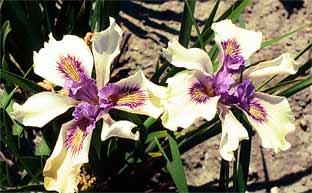
The Iris Gallery, 33450 Little Valley Road, Fort Bragg, CA 95437, telephone 1-800-757-IRIS, email: irishud@mcn.org. Website: www.allthingsiris.com. They ship in sleeves containing a soil mix, usually in the fall when root growth starts in northern California, but they will ship at any time. Sometime in late fall or December is probably best for our climate. They have a catalog with colored pictures. Their advice: The irises "�need a lime-free soil and, in warm areas, should be planted in a mostly shady area. Good drainage is very important - try to plant on raised beds, mounds, or slopes.
Another mail-order source is Bay View Gardens, 1201 Bay St., Santa Cruz, CA 95060, telephone (831) 423-3656, email: bayview@mail.USA.com. Joe Ghio sells mostly his own introductions, plus those of Lois Belardi. Ghio's advice: "Plant Pacificas in an acid bed...in all but coastal locations, filtered shade seems to provide the best results. Some water seems necessary if your summer is hot and dry. Upon receipt, soak in a bucket of water for about 24 hours. If new white roots are not showing, leave rhizomes in water until new roots begin to appear. They should appear in 7 to 10 days. Plant immediately; never allow the roots to dry out. Soaking in a fungicide like Subdue and drenching the bed with same, seems to be beneficial." Ghio ships in October to early November.